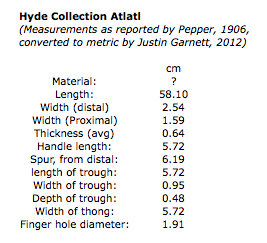The Hyde Collection Atlatl: A Basketmaker atlatl from Grand Gulch, UT Justin Garnett, 2012 
Drawing of Hyde Collection atlatl by George H. Pepper. An excellent, early description of a Basketmaker II atlatl was given by George H. Pepper in the 1902 edition of The International Congress of Americanists. In this article, Pepper gives detailed descriptions of these weapons, as well as of many other related items, such as foreshafts, items which warrant (and will soon receive) their own pages on this website. The exact provenience of the weapon is unreported, however it was apparently discovered in Grand Gulch, a Utah Canyon riddled with Basketmaker and Pueblo ruins tucked into alcoves in the sheer, looming sandstone walls. The atlatl was found in 1894 by the team of McLoyd and Graham, and was in association with a desiccated human burial. The atlatl exchanged hands several times, and was sketched and measured by Pepper in 1908. The wood of the atlatl is unidentified by Pepper, however it is described as being in a remarkable state of preservation. The surface was smoothed and polished. The loops are constructed of a folded strip of hide (identified by Pepper as rawhide), slit at the middle and slid up the shaft. The hide is oriented fold-up, creating a double-ply strip. There do not appear to be constrictions carved into the wood beneath the finger loops. The loops are bound to the shaft with sinew cordage and then the free ends of the hide doubled back to form the loops, and sewn in place around the shaft. This is a very similar construction technique to that utilized on the Broken Roof Cave atlatl discovered near the Utah-Arizona border in Northeastern Arizona. Interestingly, in Pepper’s drawing there appears to be a narrow sinew band around the atlatl handle below the loops. This band is not addressed in Pepper’s description of the weapon, and a purpose does not seem readily apparent from the drawing.
International Congress of Americanists 1902 edition was scanned and digitized by the efforts of Google books, is free of copyright, and can be viewed in it’s entirety at the following location: International Congress of Americanists, 13th edition, 1902 Reference: “The Throwing-Stick of a Prehistoric People of the Southwest.” George H. Pepper, 1902. The International Congress of Americanists, 13th Session Held in New York, 1902. Eschenbach printing company, 1905.



What do you call the grip with a side-peg? It’s a variation on a siglne hole? That’s what I use. I find it a lot better than a siglne-hole. I can’t do hammer grip at all.
Charlie, I guess you would call it a single side-peg grip. Mostly we’ve just established some common descriptive terms to denote the more common grip types. What you’re using sounds similar to some of the Inuit throwing boards.
whats the penetration power on the atlatl and dart? is it better than the bow and arrow?
John,
There isn’t really a good or simple answer to that question. There are a lot of factors that are involved in penetration-projectile speed, projectile mass, impact angle, projectile integrity, blade sharpness, etc etc etc. In general I would say my ~2-3 oz Basketmaker darts (the way I throw them) have about the killing power of a 40lb or so bow. Heavier darts can carry more impact energy, but come with their own tradeoffs, such as with mobility. You have to remember some darts are very light, some very heavy, some bows strong, some weak, some arrows light, some heavy.
So anyway, I think the best answer I can give is:
Q: Is atlatl dart penetration better than arrow penetration?
A: Sometimes.